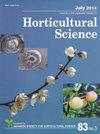Expression and Regulation of Senescence-related Genes in Carnation Flowers with Low Ethylene Production during Senescence
Journal of The Japanese Society for Horticultural Science
Pub Date : 2013-04-01
DOI:10.2503/JJSHS1.82.179
引用次数: 14
Abstract
We investigated ethylene production, ethylene biosynthesis genes, and senescence-related genes in flowers of a carnation (Dianthus caryophyllus L.) cultivar ‘Miracle Symphony’ (MS) and lines 006-13 and 62-2, which have a longer vase life than flowers of ‘White Sim’ (WS). WS flowers showed typical symptoms of senescence, but flowers of MS, 006-13, and 62-2 did not show symptoms of senescence, although they showed differences in vase life and ethylene production by day 15. The flowers of 006-13 and 62-2 produced small amounts of ethylene as a result of the low expression of two ethylene biosynthesis genes, DcACS1 and DcACO1; those of MS produced extremely low levels of ethylene. By day 15, the flowers of 006-13 and 62-2 showed increased expression of some senescence-related genes (DcCP1, DcbGal, DcGST1, and DcLip) that were upregulated by exogenous ethylene, indicating that a low level of ethylene production could induce the senescence of petals. In contrast to the upregulation of these senescence-related genes, the expression of DcCPIn, which was downregulated by exogenous ethylene decreased in petals of MS, 006-13, and 62-2 during flower senescence and was the same in all three lines at day 15. The results suggest that extended vase life depends on reduced levels of ethylene production, ethylene biosynthesis gene expression, and senescence-related gene expression.低乙烯产香康乃馨衰老相关基因的表达与调控
本文研究了康乃馨(Dianthus caryophyllus L.)品种“Miracle Symphony”(MS)和品系006-13和62-2的乙烯生产、乙烯生物合成基因和衰老相关基因,这些品系比“White Sim”(WS)的花瓶寿命更长。WS花表现出典型的衰老症状,而MS、006-13和62-2花没有衰老症状,尽管它们在花瓶寿命和第15天的乙烯产量方面存在差异。006-13和62-2两种乙烯合成基因DcACS1和DcACO1的低表达导致花产生少量乙烯;而MS产生的乙烯含量极低。到第15天,006-13和62-2的花朵显示出一些衰老相关基因(DcCP1、DcbGal、DcGST1和DcLip)的表达增加,这些基因被外源乙烯上调,表明低水平的乙烯产生可以诱导花瓣衰老。与这些衰老相关基因的上调相反,外源乙烯下调的DcCPIn在MS、006-13和62-2的花瓣中表达量在花朵衰老过程中下降,在第15天3个品系中表达量相同。结果表明,花瓶寿命的延长取决于乙烯产量、乙烯生物合成基因表达和衰老相关基因表达水平的降低。
本文章由计算机程序翻译,如有差异,请以英文原文为准。
求助全文
约1分钟内获得全文
求助全文
来源期刊
自引率
0.00%
发文量
0
审稿时长
>36 weeks

 求助内容:
求助内容: 应助结果提醒方式:
应助结果提醒方式:


